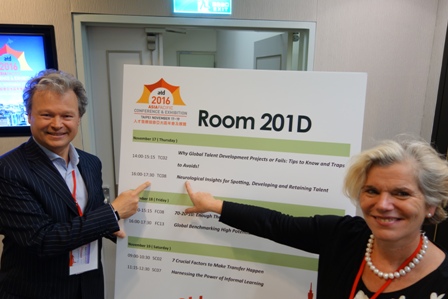Ria van Dinteren and I are back from our wonderful speaking engagement at the 2016 ATD Asia Pacific Conference in Taipei. Our presentation was met with enthusiasm and we’re now busy following up with all the wonderful people we’ve met.
Ria and I weren’t only there to speak, we fortunately got the opportunity to attend some of the sessions as well. I’d like to share some of these ‘Taipei Tales’ with you over the coming weeks.
Firstly: Dr. Wayne F. Cascio, Distinguished University Professor at the University of Colorado, on Engaging Non-Standard Workers.
Nonstandard
In the Netherlands, the market for flexible workers has grown dramatically in the last few years. Non-standard workers are almost everywhere, nutritionists and nurses, trainers, teachers and coaches, plasterers and painters, even labourers and lawyers. It seems that there are hardly any professionals left using standard work contracts.
How would we define nonstandard workers? They are “something other” than ‘standard’ workers who work:
- to a fixed schedule,
- at the employer’s place of business,
- under the employer’s direction, and
- with a mutual expectation of continued employment.
Now we know what a nonstandard worker isn’t, do we know what nonstandard work is?
Potential
PWC estimates the potential for the worldwide nonstandard labour market will reach 335 billion dollars by 2025. It’s a (work)force, both literal and financial, to be reckoned with.
Reward
During the ATDAPC session, Dr. Cascio covered several measures for increasing engagement with nonstandard workers: from offering rewards and incentives, through transforming leadership to creating innovative cultures.
What was inspiring for me, were the practical examples Dr. Cascio offered of groundbreaking market places for talent on the internet.
Upwork (www.Upwork.com) - the biggest internet marketplace for freelancers. I’ve used Upwork and I’m a fan of micro-tasking through their platform.
Tongal (https://tongal.com) - a platform to build creative content for every platform
99Designs (https://99designs.com) - a platform to find creative freelance designers online
Evolve
However, here’s the thing. Is talent management evolving in tandem with these micro-tasking and nonstandard working trends? Is strategic workforce planning adding nonstandard workers to their list of key and critical positions? To be honest, I see little progress in this regard in many of the organizations I work with. Despite the fact that some positions (think data scientists or business analysts) are incredibly hard to hire on full- or even part-time contracts.
Measure
So, we have some talent management and engagement work ahead of us, certainly in services, finance, government and industry: the areas I’m most involved in professionally.
How does your organization measure up? Can nonstandard workers count on your continued support, even after their assignments have completed? Are nonstandard workers as much part of a strategic workforce planning process as regular employees? We would love to hear what you think.
